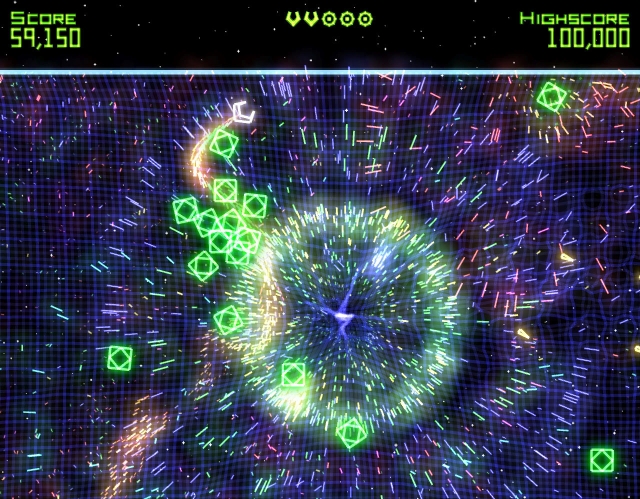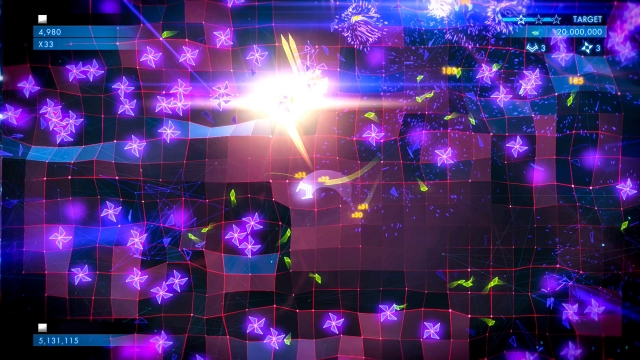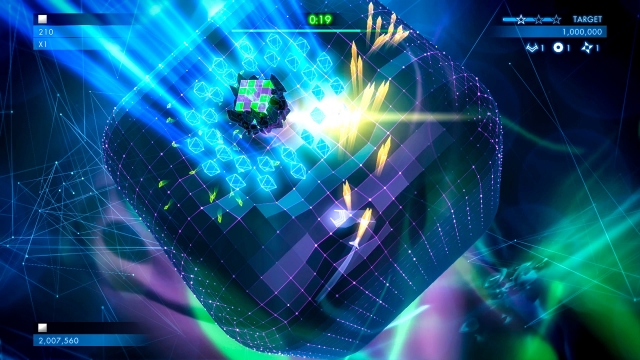
Retro Evolved - Geometry Wars
Geometry Wars was created by Bizarre Entertainment as a mini-game, included in Project Gotham Racing 2 (one of my favourite racing games, especially the series’ beginnings as Metropolis Street Racer on my beloved Dreamcast - although quite what the series has to do with either Batman and Superman's hometowns is anyone's guess!) as a throwaway extra in the garage area of the game. Anyone who has every played Robotron or Smash TV will be familiar with the "left-stick moves, right-stick fires in any direction" mode of play, an instinctual control system which requires zero training or acclimatisation period. Enemies in the form of simple geometric shapes spawn and swarm - each enemy with a different movement pattern to memorise - and you have to shoot them to earn points and stay alive. That's it!
It's the simplicity of these controls and play patterns I love, because at a glance anyone can pick up and play them for a quick few minutes of enjoyment, but as with all the best of the retro games they hold hidden depths.

To truly excel in Geometry Wars takes a mixture of skill, reflexes, memory, patience and stubbornness. A lot of videogames these days (I say shaking my walking stick at the young whipper-snappers on the lawn) are designed with the idea in mind that you only fail in the same place once or twice, and succeed on your third attempt, after which point you clear that section, save the game, move on, and in all-likelihood never return to that part of the game. This happens time and time again in all the big-budget behemoths that dominate the (paid for) best-seller sections at your local videogame store. With Geometry Wars, you have to be prepared to die. A lot. Most of the game becomes almost subconscious responses and second nature - if you stop to think about what you'll do next, you will die - and nothing becomes more second nature than dying once, knowing that solitary death has scuppered your high-score chances, and restarting the level instinctively.
The first Geometry Wars released on its own; Geometry Wars: Retro Evolved, was a fairly standard affair. The play-pattern was as mentioned above but with nicer graphics, rudimentary backgrounds, a nice soundtrack, and the "Evolved" method of play meant higher scores thanks to a basic multiplier system; the longer you stay alive the more enemies are worth. The "Retro" game option was still included, for purists.

The Nintendo DS version: Geometry Wars Galaxies (later ported to the Wii) was probably the most important release in the game's history - not for its commercial or critical success, but because of its new play features. It experimented with new levels designs, meaning you were no longer restricted to the generic rectangular shaped field of play - these new levels often came with targets to reach which would unlock the next level, something which played to the strengths of handheld videogaming with quick, casual play, and your "quest" throughout the Galaxies could be saved for next time. However, the biggest evolution to the game came with the addition of the multipliers and the drone. Multipliers are provided by mini-power-ups known as Geoms which are picked up when they are dropped by dead enemies. This added a whole new dimension to the game, as they increase the value of every enemy you kill, allowing your score to increase exponentially. Each enemy might start off as being worth a meager 100 or 200 points, but once you've got a couple of hundred multipliers racked up even the most generic of shapes becomes a very worthy kill, and brings you ever closer to that new high-score. Adding to that; the drone meant you had an extra helping hand following your ship around; you could program the drone for attack, defence, collecting Geoms, and more.
This multiplier power-up system was kept for the second Geometry Wars game, imaginatively titled Geometry Wars 2, which also added a few nice new play-patterns. As well as a multiplayer version (also first introduced in the DS game), it introduced Deadline (play against the clock), King mode (you can only fire from inside a safety bubble which fast expires), Pacifism (you can't fire!), Waves (1 life, basically survival mode), Sequence (clear each wave against the clock and collect time) and good old Retro Evolved. I've always felt this is the weakest of the downloadable Arcade games, probably because after the Nintendo game it didn't feel like a step forward as much as a step back. However, when you take the play features and new enemies added in this game and combine them with the new the innovations of the DS game, you get something very special indeed...
Geometry Wars 3!

Released late November in 2014, it is without question my favourite game in the series and my most played game of the year. I have sunk huge amounts of time into this game.
The main game is 50 levels, each with a different play-pattern or target similar to the six modes of play presented in GW2, some of which have different shaped play areas as seen in GW:G, broken up by boss battles every ten levels. Every time you clear a level you unlock the next, and you fight your way through to the final boss. Just like all the classic games of old which I love. The beauty of the game comes with a 3-star system for each level; the more points you get in a level, the more stars you are rewarded. Just one star clears the level, 2 stars shows you're a GW hero, and 3 stars means you've really put some time into this game! You can also power up your drone as you advance through the game, meaning there is always a reason to go back to an earlier level and think that maybe this time you'll be able to improve your score, and the choice of power-ups you get and when you choose to use them in a level can also greatly affect things. The leaderboards show you just where you rank in the world if you need more motivation.
The 50 different levels are so distinct and diverse from each other, it is like you have 50 different games in one! Some require defensive playing, some strategy, some timing, and some outright balls-deep bravery! Anyone can pick up and play the game as I said before, but getting three stars on all fifty levels takes some real skill!

If that wasn't enough, once you've cleared those 50 levels you get another 40 levels with Ultimate mode (really, really hard! I have scored 90th place - in the world - on some levels and still only gotten two stars for the level), this mode really requires you to think about your drone usage and power-ups. Then there is Hardcore mode, which features 20 more levels, some of which look very familiar but with a slight twist, and this time you have no drone or power-ups to help you out. It's hard to believe that this cost the same price on release as GW1 and GW2, when you're getting so much more game for your money.
On top of that, you also get five modes of classic play similar to what we saw in GW2, including good old classic Retro Evolved play which really makes you realise how far the game has come, and three bonus levels (well, two really, one is a glorified credits roll) to keep you challenged.
If you like your games old-school, hard, frantic and with a play pattern that rewards reflexes and single-mindedness above all else, I seriously recommend Geometry Wars 3! When the thought of spending five or six hours just to clear the first few cut-scenes, character introductions, and learn the control system of a new game bores the hell out of me, I can quite happily sit down for a "quick" bash of GW, one which quickly develops into five or six hours of constant frenetic, balls to the wall action! If my experience with the franchise is anything to go by, it'll keep you coming back for more, for years.








COMMENTS